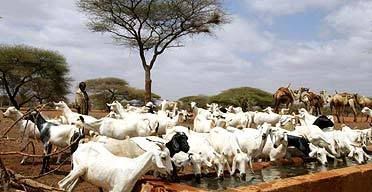 When it comes to hemorrhagic fevers, Ebola and Marburg tend to get the lions' share of the press. Both are highly fatal, both can cause people to die in excruciating ways, and both have come to represent somewhat our fear of and fascination with emerging exotic diseases. However, as I've pointed out previously, as far as actual fatalities--or even illnesses go--both viruses are small potatoes. Other viruses that can also have hemorrhagic manifestations--including dengue and yellow fever--are much more common. One of these other viruses that frequently causes hemorrhagic fever is Rift Valley fever (RVF), an arbovirus (arthropod-borne) found primarily in Africa.
When it comes to hemorrhagic fevers, Ebola and Marburg tend to get the lions' share of the press. Both are highly fatal, both can cause people to die in excruciating ways, and both have come to represent somewhat our fear of and fascination with emerging exotic diseases. However, as I've pointed out previously, as far as actual fatalities--or even illnesses go--both viruses are small potatoes. Other viruses that can also have hemorrhagic manifestations--including dengue and yellow fever--are much more common. One of these other viruses that frequently causes hemorrhagic fever is Rift Valley fever (RVF), an arbovirus (arthropod-borne) found primarily in Africa.
The RVF virus can be spread by mosquitoes, and more commonly infects domestic animals (such as cattle and sheep) than it does humans. Indeed, a clue that an outbreak of RVF is in progress in animals is the sudden onset of spontaneous abortions in livestock: the abortion rate among infected, pregnant ewes is close to 100% for this virus, for example. Additionally, these livestock outbreaks can put humans in more frequent contact with the virus, leading to a "spillover" of disease from the animal population into the human one. Humans can contract the virus either via direct contact with infected animals (including blood, animal organs, other body fluids) or due to bites from mosquitoes carrying the virus. A prime example of this spillover is an epidemic in Kenya during the mid-20th century that occurred in sheep (100,000 died), and subsequently led to human cases of the disease. Now, Kenya is facing a new outbreak of the virus in humans:
About 75 people have died in Kenya of Rift Valley fever during the past three weeks and another 183 are infected with it, according to a senior health official.The death toll from the hemorrhagic fever _ a virus which spreads from animals to humans by mosquitoes and through contact with raw blood, milk and other bodily fluids _ could be higher because the figures are only of adult victims. The affected people in the Northeastern Province rarely record the deaths of their children, Dr. Ahmed Omar Ahmed, the province's chief medical officer, said Sunday.
RVF is similar to dengue in that the hemorrhagic form of the disease is fairly rare--but when it progresses to that stage, it's highly fatal (~half of hemorrhagic patients die). A previous outbreak in the area in 1997-8 resulted in almost 500 deaths from the virus; larger than any Ebola or Marburg outbreak.
There is concern that the disease outbreak has also spread to Somalia, where 7 people have already died from suspected RVF. However, the fighting in the area has made it difficult to send anyone in to investigate the deaths:
Fighting in southern Somalia has hampered efforts to confirm a possible spread of Rift Valley Fever (RVF) from neighbouring Kenya to the Lower Juba Region where seven people have died after showing symptoms of the rare, contagious haemorrhagic disease, Somali health officials said.
The deaths were reported in Dobley, 18 km north of the Kenyan border, in the last five days. "The dead are mainly nomadic herders," said Hassan Mursal, a clinical officer in nearby Afmadow hospital. "The number could be higher but because of the current insecurity in the area there is no way of getting the full picture."
Mahamud Haji Hassan Jabra, an epidemiologist with the European Union-funded Somali Animal Health Service Project, said numerous reports of animal abortions - a key indicator of the disease - had been received from the area. But plans to send two teams to verify the outbreak would only go ahead once the security situation allowed.
"Our focal point in the area has reported the clinical signs of the disease but we need to confirm this by testing the samples collected," he said. "If it turns out to be RVF it will have a devastating impact on the livelihoods of the pastoralists, who have suffered two years of drought followed by heavy flooding."
This heavy flooding in both regions is one reason why RVF is hitting now. As I mentioned, the virus can be transmitted by mosquitoes--and a variety of species can carry it. Some of these transmit the virus transovarially: from mother to offspring via the egg. Many of these eggs are hardy, laid by female mosquitoes years ago and just waiting for the right conditions--like the current flooding--to hatch. And while there's little people in the area can do about periodic flooding, scientists are actively examining the relationship between weather and RVF outbreaks. This hopefully will prove useful to predict--and potentially ward off--future disease outbreaks via animal vaccination.
In the case of the current outbreak, the first story notes that 400,000 doses of the animal vaccine have been donated by the U.S., but that's only enough to vaccinate about a quarter of the animals in the region--and will be even less useful if the outbreak has spread. There's no vaccine available for humans, so they're left with two ways of prevention: trying to avoid potentially infected animals, and avoiding infected mosquitoes--neither of which are easy to do when you're living in poverty and animals are your livelihood, unfortunately.
